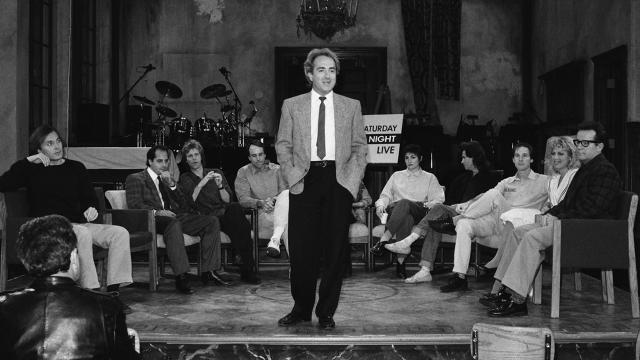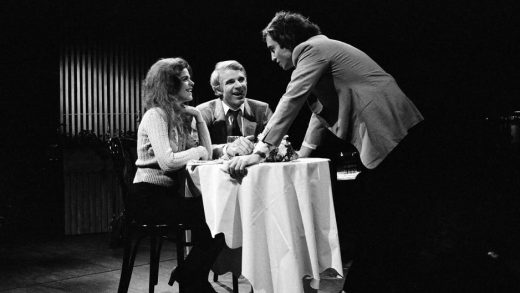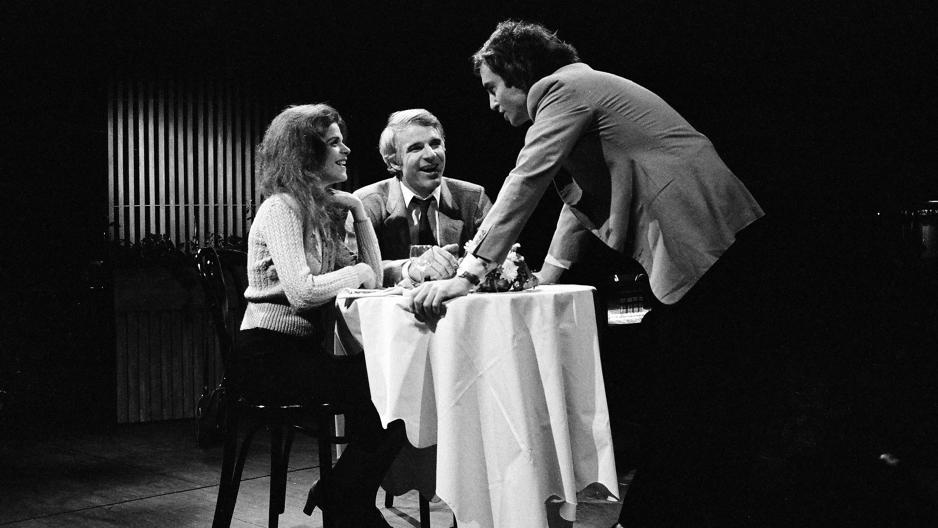The Management Secret That Makes SNL’s Chaotic Writers Room Succeed
You’ve been invited to join one of two teams of comedy writers working on a TV show.
The first group, Team A, is composed of exceptionally smart comedians. They’re polite and courteous to each other, and they take turns speaking. No one interrupts. When another person veers off topic and starts telling a funny story, a colleague gently reminds him to focus on the script, then steers the conversation back on track. The team is efficient. The meeting ends exactly when scheduled.
The second group, Team B, is evenly divided between successful writers and young comedians who’ve never worked on a television show before. Teammates jump in and out of the discussion haphazardly. Some ramble, others bring up half-formed ideas. They all talk so much that it’s sometimes hard to follow the conversation. When a team member abruptly changes the topic and starts telling a funny story, the rest of the group follows her off the agenda. The meeting doesn’t actually end: Everyone sits around and gossips.
Which group will be more successful in putting together the show?
Why Teams Do (And Don’t Do) Well Together
In 2008, a group of psychologists from Carnegie Mellon and MIT wondered if they could figure out which kinds of teams were clearly superior. The researchers wanted to know if there is a “collective intelligence” that emerges within a team that’s distinct from the smarts of any single member.
So the researchers recruited 699 people, divided them into small groups, and gave each a series of assignments requiring different kinds of cooperation. One assignment, for instance, asked participants to brainstorm possible uses for a brick. Some teams came up with dozens, while others kept describing the same ideas in different words.
Another had the groups plan a shopping trip and gave each teammate a different list of groceries. The only way to maximize the group’s score was for each person to sacrifice an item they really wanted for something the team needed. Some groups easily divvied up the buying; others couldn’t fill their shopping carts because no one was willing to compromise.
What interested the researchers most was that teams that did well on one assignment usually did well on all the others. Conversely, teams that failed at one thing seemed to fail at everything. The researchers eventually concluded that what distinguished the ‘‘good’’ teams from the dysfunctional ones was how teammates treated one another. In other words, the right group norms—those small habits, unwritten rules, and mutually agreed-upon ways of treating one another—could raise a group’s collective intelligence, whereas the wrong norms could hobble a team, even if, individually, all the members were exceptionally bright.
Two Behaviors That The Best Teams Share
But when the researchers reviewed videos of the good teams’ interactions, they noticed that not all norms looked alike. “It was striking how different some of them behaved,” said Anita Woolley, the study’s lead author. “Some teams had a bunch of smart people who figured out how to break up work evenly. Other groups had pretty average members but came up with ways to take advantage of everyone’s relative strengths. Some groups had one strong leader. Others were more fluid, and everyone took a leadership role.”
First, all the members of the good teams spoke in roughly the same proportion, a phenomenon the researchers referred to as “equality in distribution of conversational turn-taking.” In some teams, for instance, everyone spoke during each task. In others, conversation ebbed from assignment to assignment—but by the end of the day, everyone had spoken roughly the same amount.
“As long as everyone got a chance to talk, the team did well,” said Woolley. “But if only one person or a small group spoke all the time, the collective intelligence declined. The conversations didn’t need to be equal every minute, but in aggregate, they had to balance out.”
Second, the good teams had “high average social sensitivity”—a fancy way of saying that teammates were skilled at intuiting how members felt based on their tone of voice, how people held themselves and the expressions on their faces. They were good at picking up on non-verbal cues and really listening to what people said—and what they left unsaid—when they were talking.

The Secret To SNL’s Longevity
When executive producer Lorne Michaels started Saturday Night Live in 1975, most observers thought the show would bomb. For writers, Michaels had assembled a bunch of comedians who hardly knew each other. Most had never worked on a television show before. They were thin skinned, tended to date each other and break up, and were antisocial and anti-establishment. What’s more, the show’s writer’s room was a competitive place: When one person’s skit was put on air, another writer’s idea would get cut. Television executives thought it would be a nightmare.
And yet, today, Saturday Night Live is one of the longest-running, most successful shows on television. And if you ask the show’s writer and performers why, they’ll talk about Lorne Michaels’s leadership style. There’s something about how he runs team meetings, they’ll say, that made everything come together. Michaels himself, still the show’s executive producer, says the reason why Saturday Night Live has succeeded is because he abides by two rules: He gives everyone a voice, and he forces people to really listen to each other.
Michaels will often keep a sheet of paper during a meeting, and make a note each time someone speaks—and then won’t end the meeting until he forces everyone to talk a roughly equal number of times. And Michaels is almost ostentatious in his demonstrations of social sensitivity—and he expects the cast and writers to mimic him.
During the early years, Michaels was the one who appeared with a soothing word when an exhausted writer was crying in his office. He’s been known to interrupt a rehearsal or table-read and quietly take an actor aside to ask if they need to talk about something going on in their personal life. Once, when the writer Michael O’Donoghue was inordinately proud of an obscene commercial parody, Michaels ordered it read at 18 different rehearsals, even though everyone knew the network’s censors would never let it on the air.
Michaels says the job of modeling norms is his most important duty. “Everyone who comes through this show is different, and I have to show each of them that I’m treating them different, and show everyone else I’m treating them different, if we want to draw the unique brilliance out of everyone,” Michaels told me.
“SNL only works when we have different writing and performing styles all bumping into and meshing with each other,” he said. “That’s my job: To protect peoples’ distinct voices, but also to get them to work together. I want to preserve whatever made each person special before they came to the show, but also help everyone be sensitive enough to make the rough edges fit. That’s the only way we can do a new show every week without everyone wanting to kill each other as soon as we’re done.”
Why The B Team Wins Out
Which brings us back to the question of those two hypothetical comedy-writing teams and which one you’d rather join: the professional and experienced Team A, or the free-flowing, informal Team B.
The answer is that you should opt for Team B. Team A is filled with smart, effective people. They’ll all be successful as individuals. But as a team, they still tend to act like individuals. There’s little to suggest that, as a group, they become collectively intelligent, because there’s little evidence that everyone has an equal voice and that members are sensitive to teammates’ emotions and needs.
Team B is a lot messier. People speak over one another, they go on tangents, they socialize instead of remaining focused on the agenda. Everyone speaks as much as they need to, though. They feel equally heard and are attuned to one another’s body language and expressions. They try to anticipate how one another will react. Team B may not contain as many individual stars, but when that group unites, the sum is much greater than any of its parts.
“When I see the entire team drawing some kind of inspiration from the same thing, I know everything is working,” Michaels said. “At that moment, the whole team is rooting for each other, and each person feels like the star.”
Charles Duhigg is a Pulitzer Prize-winning investigative reporter for The New York Times and the author of Smarter Faster Better: The Secrets of Being Productive in Life and Business, a New York Times bestseller and Audible’s #1 business audiobook of 2016. Duhigg is also the author of The Power of Habit.
Fast Company , Read Full Story
(47)














